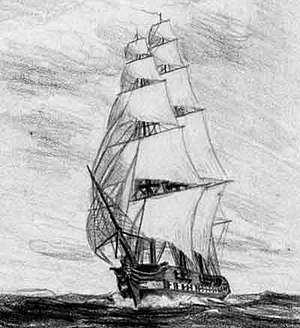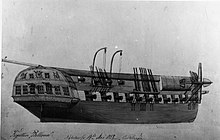HDMS Bellona (1830)
HDMS Bellona was a frigate of the Royal Danish Navy, which she served from 1835 to 1862.
 HDMS Bellona | |
| History | |
|---|---|
| Name: | Bellona |
| Owner: | Royal Danish Navy |
| Builder: |
|
| Yard number: | 23 |
| Laid down: | 30 May 1826 |
| Launched: | 15 September 1830 |
| Commissioned: | 1 May 1835 |
| Decommissioned: | 25 June 1862 |
| Status: | Broken up, 1868 |
| General characteristics | |
| Class and type: | Fourth rate frigate |
| Tons burthen: | 7051⁄2 læster |
| Length: | 48.09 metres (157 ft 9 in) |
| Beam: | 11.84 metres (38 ft 10 in) |
| Draught: | 5.42 metres (17 ft 9 in) |
| Propulsion: | Sails |
| Sail plan: | Full-rigged ship, 2129 m2 |
| Complement: | 404 |
| Armament: | 46 x 18 pounder cannon |
Design

Bellona was 48.09 metres (157 ft 9 in) long, with a beam of 11.84 metres (38 ft 10 in) and a draught of 5.42 metres (17 ft 9 in). She displaced 7051⁄2 læster. Her complement was 404 men. She was equipped with 46 18 pound cannons.[1]
A model of this ship, placed in 1840, can be seen in St. Jørgensbjerg Kirke[2][3] in Roskilde
History

Bellona was built at Nyholm to a design by A. Schifter. She was launched on 15 September 1830.[1] Commissioned on 1 May 1835,[4] she completed an expedition to the Mediterranean Sea from Copenhagen between 1 May and 5 September 1835. She was under the command of captain L. de Coninck and brought back some of Bertel Thorvaldsen's works.[1]
Voyage to South America
_(20360703852).jpg)
From 24 August 1840 to 21 August 1841, under command of captain Christian Wulff[5], she completed a voyage to South America.[1] The primary purpose of this voyage as establishment of trade agreements with the South American states, but also to establish contact to emigrated Danish citizens and in general flag the Danish flag in the new world. Scientific expeditions were also in fashion (not the least the recently completed voyage of HMS Beagle 1831-36 with Charles Darwin on board) and the Danish King Christian VIII had a keen interest for natural sciences. Thus on board Bellona was the 41 year old naturalist Henrik Nikolai Krøyer. Almost nothing is known from direct sources about Krøyer's work on Bellona, but indirectly from his later scientific publications it is evident that he collected a wealth of animals, in particular crustaceans.[6]
First Schleswig War and later years
In 1847, from 15 May to 18 August, she was commissioned to pick up a load of cereal products in St. Petersburg.[1]
She was then equipped for service in the First Schleswig War.[1] On 10 August 1849, she ran aground in the Elbe whilst blockading Hamburg. The blockade was due to be lifted the next day.[7]
She was in use as an Eksercerskib from 16 May to 25 September 1858. She was decommissioned from the Navy on 25 June 1862. She was for a while used as a storage facility at Høruphav in 1864 before being broken up in 1868.[1]
References
- "BELLONA (1835-1862)". navalhistory.dk (in Danish). Retrieved 23 August 2018.
- Marcussen
- Danish Naval Museum - Skibregister - Bellona
- "Danish Fourth Rate frigate 'Bellona' (1830)". Threedecks. Retrieved 31 October 2018.
- Topsøe-Jensen Vol 2 pages 741 -743
- Wolff, Torben (1967). Danish Expeditions on the Seven Seas. Copenhagen: Rhodos.
- "Denmark and the Duchies". Daily News (1004). London. 14 August 1849.
External links
- Fregatten Belonas togt til Sydamerika 1840-41
- Den danske besejling af Sydamerika i det 19. århundrede
- Source
- Danish Naval Museum website - then click Skibregister, then B, and the Bellona record is on page 2. - - the ship's record, which gives further references to Topsøe-Jensen for the naval officers who saw service in this ship
- Marcussen Website
- T. A. Topsøe-Jensen og Emil Marquard (1935) “Officerer i den dansk-norske Søetat 1660-1814 og den danske Søetat 1814-1932“. Two volumes
- Orlogbasen - the database for all ships in the Danish Navy.